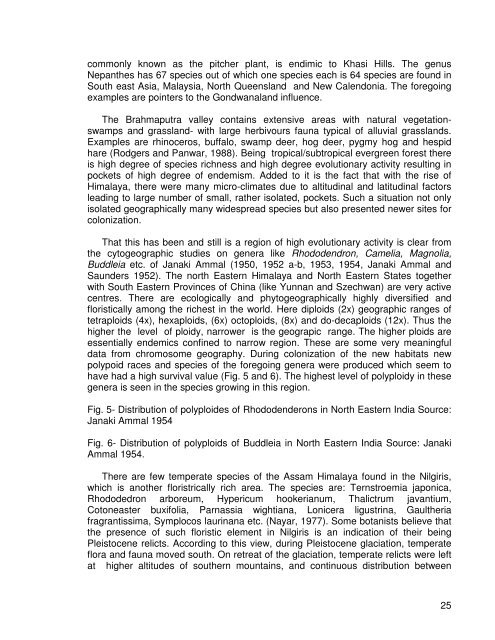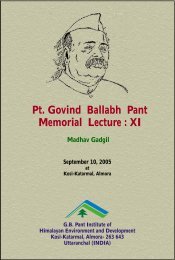Pandit Govind Ballabh Pant Memorial Lecture: II
Pandit Govind Ballabh Pant Memorial Lecture: II
Pandit Govind Ballabh Pant Memorial Lecture: II
You also want an ePaper? Increase the reach of your titles
YUMPU automatically turns print PDFs into web optimized ePapers that Google loves.
commonly known as the pitcher plant, is endimic to Khasi Hills. The genus<br />
Nepanthes has 67 species out of which one species each is 64 species are found in<br />
South east Asia, Malaysia, North Queensland and New Calendonia. The foregoing<br />
examples are pointers to the Gondwanaland influence.<br />
The Brahmaputra valley contains extensive areas with natural vegetationswamps<br />
and grassland- with large herbivours fauna typical of alluvial grasslands.<br />
Examples are rhinoceros, buffalo, swamp deer, hog deer, pygmy hog and hespid<br />
hare (Rodgers and Panwar, 1988). Being tropical/subtropical evergreen forest there<br />
is high degree of species richness and high degree evolutionary activity resulting in<br />
pockets of high degree of endemism. Added to it is the fact that with the rise of<br />
Himalaya, there were many micro-climates due to altitudinal and latitudinal factors<br />
leading to large number of small, rather isolated, pockets. Such a situation not only<br />
isolated geographically many widespread species but also presented newer sites for<br />
colonization.<br />
That this has been and still is a region of high evolutionary activity is clear from<br />
the cytogeographic studies on genera like Rhododendron, Camelia, Magnolia,<br />
Buddleia etc. of Janaki Ammal (1950, 1952 a-b, 1953, 1954, Janaki Ammal and<br />
Saunders 1952). The north Eastern Himalaya and North Eastern States together<br />
with South Eastern Provinces of China (like Yunnan and Szechwan) are very active<br />
centres. There are ecologically and phytogeographically highly diversified and<br />
floristically among the richest in the world. Here diploids (2x) geographic ranges of<br />
tetraploids (4x), hexaploids, (6x) octoploids, (8x) and do-decaploids (12x). Thus the<br />
higher the level of ploidy, narrower is the geograpic range. The higher ploids are<br />
essentially endemics confined to narrow region. These are some very meaningful<br />
data from chromosome geography. During colonization of the new habitats new<br />
polypoid races and species of the foregoing genera were produced which seem to<br />
have had a high survival value (Fig. 5 and 6). The highest level of polyploidy in these<br />
genera is seen in the species growing in this region.<br />
Fig. 5- Distribution of polyploides of Rhododenderons in North Eastern India Source:<br />
Janaki Ammal 1954<br />
Fig. 6- Distribution of polyploids of Buddleia in North Eastern India Source: Janaki<br />
Ammal 1954.<br />
There are few temperate species of the Assam Himalaya found in the Nilgiris,<br />
which is another floristrically rich area. The species are: Ternstroemia japonica,<br />
Rhododedron arboreum, Hypericum hookerianum, Thalictrum javantium,<br />
Cotoneaster buxifolia, Parnassia wightiana, Lonicera ligustrina, Gaultheria<br />
fragrantissima, Symplocos laurinana etc. (Nayar, 1977). Some botanists believe that<br />
the presence of such floristic element in Nilgiris is an indication of their being<br />
Pleistocene relicts. According to this view, during Pleistocene glaciation, temperate<br />
flora and fauna moved south. On retreat of the glaciation, temperate relicts were left<br />
at higher altitudes of southern mountains, and continuous distribution between<br />
25











